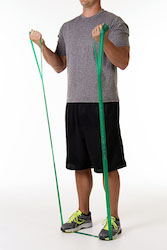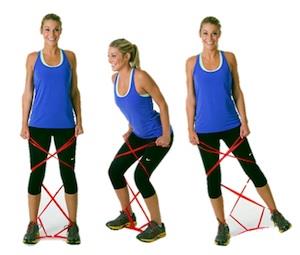Do you struggle to add exercise into a busy schedule of work and home responsibilities? A study by Harvard Nurses’ Health found that more than half of the respondents exercised for less than 2 hours a week, often as a result of long hours and rotating shifts.1 While finding time can be a challenge, it’s important to make time to workout – for both your mental and physical health.
Why Exercising Matters for Nurses
- Improve your health and reduce your risk of lifestyle-related diseases
- Reduce your risk of work-related injury (patient lifting, equipment transportation, etc.)
- Increase your understanding of the importance of fitness on prevention and rehabilitation
- Reduce your stress (decrease adrenaline and cortisol and boost endorphins)
- Add as part of your self-care routine
- Be a good role model for your patients
A Study
Too much stress and not enough sleep, sounds familiar? One study looked at a 10 year modifiable cardiometabolic risk in female patient care workers (68% nurses). The cardiometabolic risk was measured using changes in systolic blood pressure, Hb A1C, BMI and HDL cholesterol.
The research found that in workers prone to work-related stress and sleep deficiency, maintaining sleep and exercise patterns had a significant effect on reducing that risk.2
How much exercise do you need?
Some exercise is better than none at all, but the American Heart Association recommends3:
|
|||||||||||||||
How to Fit Gym Time Into Your Schedule
One of the hardest aspects of working out is finding time. For some, hitting the gym after a 12 hour shift is the last thing you want to do. For others, dragging yourself out of bed and to the gym before work is a near-impossible task. What works best for you will depend on a few factors.
Questions to Ask Yourself
- Are you a morning person or a night person?
- If waking up at 4 a.m. to make it to the gym will make you miserable, you might be better off exercising after your shift. If you’re ready to go after waking up, try to make it to the gym before heading into work.
- How does working out make you feel?
- If it tires you out, work out after your shift ends and take advantage of the exhaustion to help you sleep. If it energizes you and wakes you up, go to the gym before you start your shift and carry that energy into work.
- Do you need help sticking to your exercise routine?
- Consider signing up for classes. When you pay for a class, you feel more obligated to go than if you just have a membership. If you have a friend to go with you’ll also be less likely to skip out.
- Do you work overnight?
- Depending on when you want to exercise, this might let you miss the rush. Look for a 24 hour gym so you can pop in at a time that fits your hours.
- How does your shift length affect your schedule?
- 8 hour shifts tend to make scheduling time to work out more manageable than 12 hour shifts. If you work 12 hours, exhaustion can make working out hard. Add it in on your days off or make time during your lunch hour. Don’t forget that sleep is important, too!
- Twelve hour overnights?
- If exercise gives you energy:
- If you have multiple 12 hour night shifts, try exercising right before work on the first day. Then, take the second and third days as rest days. Sleep after your last shift, then go work out when you wake up, and continue exercising on your days off.
- If exercise makes you tired:
- Another option is to exercise in the morning on the first day so you can sleep in the afternoon before work. Then, take the second day as a rest day. On the third day, workout right when you get off before heading to sleep. Then, continue to exercise on your days off too.
Exercising at Work
You’re on your feet all day, but changes in hospitals mean you might not get as much exercise as you think. Increased reliance on computers and nursing stations just steps away from patient beds mean lots of standing, but not a lot of movement.
Luckily, it’s easy to add exercise into your work day. It can be as simple as parking farther away, biking to work, or taking the stairs instead of the elevator. When you’re charting and doing paperwork, sit on a stability disc to engage your core and work your abdominal muscles. You can use a pedal exerciser under your desk to work your leg muscles too. Little additions make it easy to add fitness into your life.
Or spend part of your lunch break exercising. You can head outside, stick near your nurse’s station, or take some exercising time in the supply closet or stairwell. Grab ten minutes when you can and start exercising.
Not sure where to start?
- Run the stairs
- Speed walk the hallways
- Do dips and pushups on a stable desk
- Perform lunges, wall sits, and push ups
One Tool, So Many Possibilities
If you’re looking to boost your workout, get an exercise band. They’re small enough to leave in your locker or desk drawer and can be used for a variety of exercises. From bicep curls to squats, resistance bands enhance your workout. Start with a beginner set and work up from there. If you work in a latex-free facility, be mindful and choose latex-free resistance bands to avoid allergen risks.
Exercising at Home
Finding it hard to make it to the gym? Work out at home instead. You’ll save time on the commute and can work out when you’re ready. If you prefer to follow along with a trainer, head to YouTube to find an exercise video that fits your workout time frame.
Remember: you don’t need a lot of equipment to get started! A resistance band can provide an effective workout without dumbbells or heavy equipment. Here are some exercise suggestions that you can use to get started.
Exercise Ideas
|
|
If you have more time, add in some cardio to balance out strength training. You can head outside for a run or hop on a bike. Once you get into a routine, you can add other equipment. It can be something smaller like an exercise ball for crunches or core work, or you could invest in a larger machine like an elliptical or treadmill.
Good Workouts for Nurses
- Lunges: Exercise the muscles you use when lifting and transferring patients
- Circuit training: Combines the start stop movements you use at work
- Strength training: Patient transfers and equipment movement
- Cardio: Walking during rounds and racing into patient rooms
Staying Motivated
It can be hard to stick with an exercise plan. Don’t let missing one day mess up your whole week.
Find Something You Enjoy
It might be biking in spin class, joining an intramural sport, dancing in zumba, or running on the treadmill while watching TV. What matters it that you like it, that way you’ll be more likely to stick with it.
Grab a Friend
Working out is more fun when you aren’t alone. Plus, you can encourage each other. You’ll be less likely to skip knowing your friend will be disappointed and lonely.
Set a Goal
Choose a goal to work towards. It could be a certain amount of miles you want to complete when bike riding. Or maybe you want to make it to eight fitness classes in one month. Make sure it’s achievable in the short term so you don’t get discouraged. If you want to run a marathon one day, your first goal could be completing a 5k.
Make it a Competition
If you’re a competitive person, convince a few friends and co-workers to join you. Compete to see who can get the most steps. You can use a wearable device like a FitBit® tracker or an app on your phone to track your steps. Another low-cost option is a basic pedometer. Offer a single prize like pooling your money to buying the winner’s lunch. Or decide on a group prize – for example, if 85% of your friends hit their fitness goals you’ll go see a concert together.
Recap
Finding time to work out isn’t easy. You might need to experiment to discover that you hate running, but love spin class. Or maybe you can’t go to a pilates class before work but like going afterwards. Or you can try the products and exercises we mentioned above. Just start exercising – you won’t know what works until you try it!
If you haven’t had the chance, read Part 1 of this series, Self-Care for Nurses: At Work and At Home, to find out about how you can incorporate other six areas of self care into your life (plus more suggestions for physical self-care).
References
- American Nurses Association. (2013). An issue of weight. Retrieved from https://bit.ly/2MbcdSw
- Jacobsen, H. B., Reme, S.E., Sembajwe, G., Hopcia, K., Stiles, T.C., Sorensen, G., Porter, J.H., Marino, M., & Buxton, O.M. (2014). Work stress, sleep deficiency and predicted 10-year cardiometabolic risk in a female patient care worker population. Retrieved from https://bit.ly/2AQGt0A
- American Heart Association. (2018). American Heart Association Recommendations for Physical Activity in Adults. Retrieved from https://bit.ly/2OROjJL
- Harvard Health Publishing. (2018). Exercising to relax. Retrieved from https://bit.ly/2eXyeT9
Medical Disclaimer: The information provided on this site, including text, graphics, images and other material, are for informational purposes only and are not intended to substitute for professional medical advice, diagnosis or treatment. Always seek the advice of your physician or other healthcare professional with any questions or concerns you may have regarding your condition.








 France
France Australia
Australia





